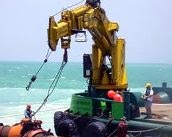Statoil ASA expects to decrease carbon-dioxide emissions per barrel from its Canadian oil-sands projects by 20% within six years, responding to environmental criticism of the crude production method.
Norway’s biggest energy producer said yesterday that carbon intensity from its oil-sands operations rose 25% from a year earlier to 69.7 kilograms of carbon dioxide per barrel.
Statoil is applying solvents to its steam-assisted techniques and will use valves to better direct steam to areas that need it, Staale Tungesvik, president of Canadian operations, said in a telephone interview. The Stavanger-based company also is considering different drilling techniques and more efficient water-recycling processes.
“The difference between oil sands and conventional oil production is that we use gas to heat water to create steam, so the footprint of CO2 is very much out of the generation of steam,” Tungesvik said. “We believe that we have identified technologies that will help us reach our target of reducing CO2 intensity by 20% by 2020.”
Emissions from Alberta’s oil sands have become a focal point for opposition to Calgary-based TransCanada Corp.’s Keystone XL pipeline, which would carry bitumen from the oil sands to U.S. Gulf Coast refineries. Opponents like billionaire Tom Steyer say the line would encourage companies to exploit the world’s third-largest crude reserves, unlocking vast amounts of carbon and accelerating climate change.
Carbon emissions from the oil sands won’t improve without new government policy, said PJ Partington, an Ottawa-based analyst at the Pembina Institute, an environmental think tank.
“Without more stringent policies to drive innovation and deployment of new technologies, carbon intensity is expected to remain flat for the foreseeable future,” Partington said by phone.
The intensity of greenhouse gases in oil-sands emissions fell 7.7% from 2008 to 2012, the Canadian Association of Petroleum Producers, an industry group, said in a Nov. 5 report.
Oil-sands crude is on average 9% more carbon intensive than the U.S. average on a wells-to-wheels basis, which measures CO2 emissions from the start of oil production through to combustion, according to the CAPP report.
Statoil’s carbon emissions from oil-sands production will likely decline this year, Tungesvik said. “With stable production and new technology, I would expect we’ll have lower numbers this year than we had last year,” he said.
By 2025, the Norwegian company has voluntarily targeted to reduce CO2 intensity at its oil-sands operations by 40%.
“It’s about earning more money,” Tungesvik said. “And we think that should go hand-in-hand to improve environmental impact.”
Providing useful resources, articles and writings on crude oil, other petroleum products, energy and gas. By Blockline and Associate Ltd Nigeria Ltd, online.

 Nigeria Bonny Light Crude Oil (BLCO, FLCO and ALCO, etc): We sell mostly on FOB, CIF, TTO and TTT/STS Basis.
Nigeria Bonny Light Crude Oil (BLCO, FLCO and ALCO, etc): We sell mostly on FOB, CIF, TTO and TTT/STS Basis. We sell and lease tug-boats of all kinds.
We sell and lease tug-boats of all kinds.

No comments :
Post a Comment